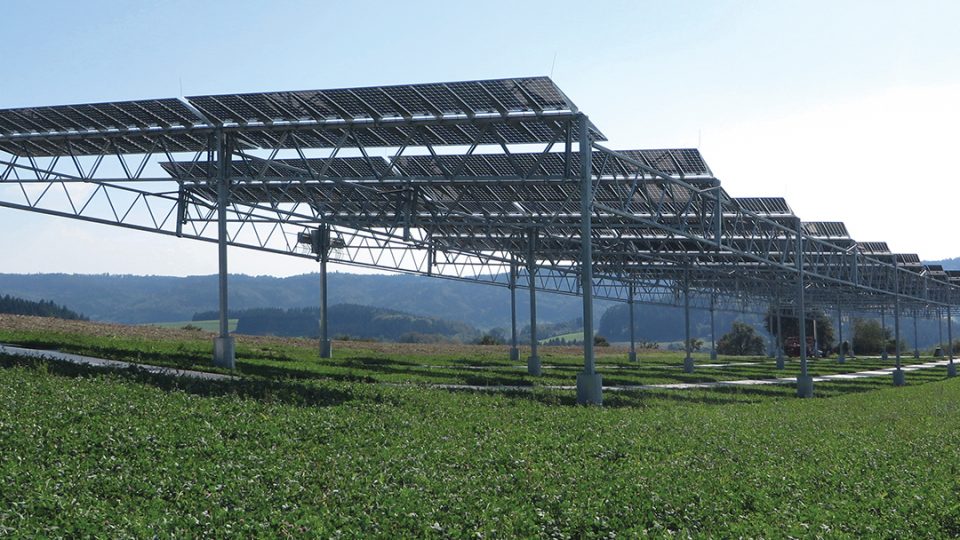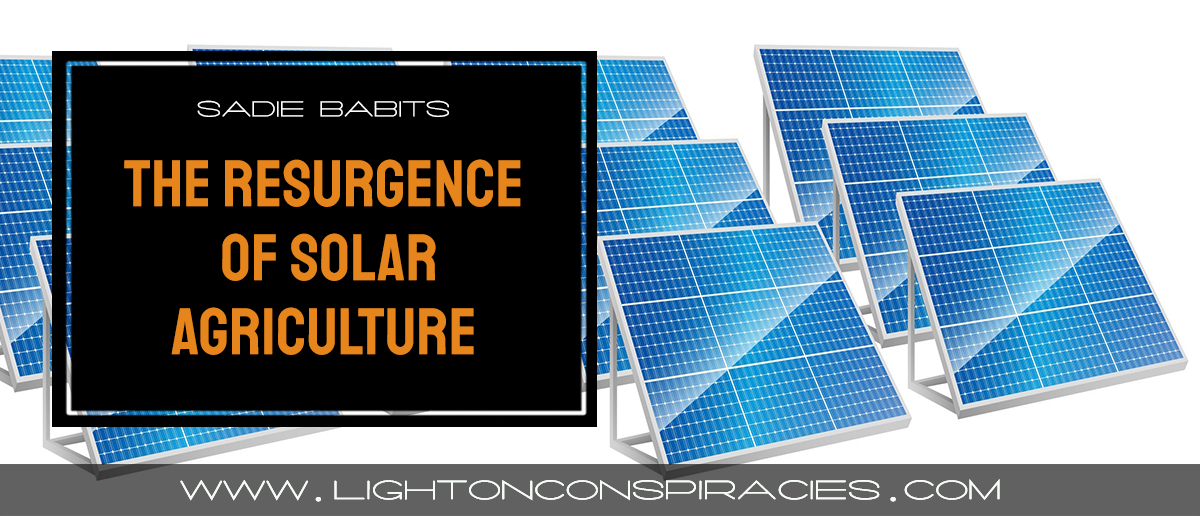
IDEA WATCH
Harvesting food and energy side by side
By Sadie Babits
Some ideas spring up overnight. Others take root more slowly, waiting for the right conditions to thrive. Agrovoltaics, a system in which solar arrays and food crops coexist on the same land, falls into the latter category.
Adolf Goetzberger, founder of the Fraunhofer Institute for Solar Energy Systems, and Armin Zastrow pioneered the idea back in 1981. At the time, photovoltaics was expensive, and computers were rare. So the pair worked out the equations for a dual-use system on programmable pocket calculators and published a paper titled Kartoffeln unterm Kollektor (Potatoes under Panels)—which Goetzberger later noted was apt because potatoes grow better with a bit of shade.
Thirty-five years later, it seems the world is ready for their idea. The price of solar panels has plummeted—by more than 50 percent since 2010 alone—and many farmers find it more lucrative to grow crops for fuel instead of food, or to put their land under vast solar arrays. For any one farmer, the switch makes economic sense. But cumulatively it sets up a zero-sum game that could undermine food security around the world.
Agrovoltaics is one way out of the dilemma. That is, if it can work at a scale commensurate with the world’s voracious appetite for food and energy. And therein lies the pivotal question: Can farmers get the same food production under solar panels that they currently do growing lettuce for your dinner table the old-fashioned way—directly under the sun? There’s an increasing body of research suggesting that they can.
Too much shade can hurt the crops. And too little can hurt electricity generation. Proper spacing between the solar panels, together with the tilt of the arrays, is key to getting the right mix of electricity and crop production.
In 2010, Christian Dupraz and his colleagues at the French National Institute for Agricultural Research built the first agrovoltaic research farm near Montpellier. They planted two crops under full sun, while another crop went under a standard-density array of photovoltaics—the type of panels that generate the most electricity. The third crop grew under half-density arrays, which allowed more light through the solar panels.
At the end of three growing seasons, crops grown under the full density panels had lost nearly 50 percent of their productivity. That wasn’t particularly surprising. What was remarkable was that the plants under half-density panels were just as prolific, if not more so, than the plants under full sun.
Researcher Hélène Marrou explained, for example, that the lettuce adapted to low light by increasing leaf size. She also wrote in a 2013 paper that in a warming world where water could be in short supply, shading plants under solar panels could reduce the need for water. “We showed in this experiment that shading irrigated vegetable crops with PVPs (photovoltaic power systems) allowed a saving of 14 percent to 29 percent of evapotranspired water, depending on the level of shade created and the crop grown.”
The takeaway is that too much shade can hurt the crops. And too little can hurt electricity generation. Proper spacing between the solar panels, together with the tilt of the arrays, is key to getting the right mix of electricity and crop production.
Building on the French results, German researchers from the Fraunhofer Institute—launched by none other than Adolf Goetzberger—have taken up the question of agrovoltaic viability for larger farm operations. On one-third of a hectare of cropland near Germany’s Lake Constance, they installed 720 bi-facial solar panels—meaning they catch rays from above and below. Unlike those in France, however, their panels are mounted high off the ground to allow the most sunlight possible to reach the crops and to enable large farm equipment to move under the arrays.
In September 2016, the researchers connected the solar pilot plant to the grid and planted winter wheat, celery, potatoes, and clover under the arrays. After the first year, the combined yield of food and electricity was 60 percent higher per square meter than it would have been if food and electricity had been harvested on two separate fields.
The clover did the best, losing about 5 percent in productivity compared to clover grown under full sun. The potato, wheat, and celery yields were lower by about 19 percent compared to test plots without solar panels. “Overall electricity generation far outweighed agricultural losses,” explained Benedikt Klotz, a student assistant at the Fraunhofer Institute.
The panels supplied enough energy to power 62 homes for one year; the goal, Klotz said, is to increase that in the future. The pilot study is scheduled to last three years. “Eventually, we want to lead APV (agrophotovoltaics) to an industry-ready stage for large-scale construction.”
Hypothetically, if all the lettuce grown in the U.S. were converted to agrovoltaic systems, it could double the nation’s entire installed photovoltaic capacity.
So how big can this go? That’s the question a number of recent modeling studies have tackled. Michigan Technical University engineer Joshua Pearce, for example, wondered what would happen if solar panels were installed on grape farms in India. Considering the shade tolerance of grapes, he and colleagues created a techno-economic computer model, plugged in the numbers, and found the economic value of Indian grape farms could increase more than 15 times, compared to traditional farming— with no decline in grape yields. If this dual use of land happened across India,
energy generation would potentially be more than enough to supply 15 million people with electricity.
Pearce and colleagues also looked at lettuce farming in the US. Hypothetically, if all the lettuce production in the US were converted to agrovoltaic systems, photovoltaic power generation could increase by 40 to 70 gigawatts. To put that into perspective, this amount would nearly double the entire installed photovoltaic capacity in the US at the end of 2017.
And that’s just lettuce. On to broccoli.
____________________
Sadie Babits is a Ted Scripps Journalism Fellow at University of Colorado, Boulder, where she’s focusing on stories about America’s public lands. Most recently, she was News Director at Colorado Public Radio.
Original Article













